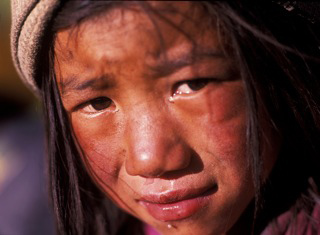In 1949 the People's Liberation Army invaded Tibet; what - in a gross distortion of events - China called the 'Peaceful Liberation of Tibet'. For Tibetans and their supporters, it is almost 7 decades since the People's Republic of China moved aggressively to consolidate its military occupation of Tibet. The '17 Point Agreement', signed on 23 May 1951 by the Chinese government and by the Tibetan government under duress, collapsed under growing opposition to Chinese rule among Tibetans and the escape of the Dalai Lama in 1959 (a).
China has now ruled Tibet for almost a lifetime; a lifetime in which to win Tibetan hearts and minds, to weaken the influence of the exiled Dalai Lama, and to assimilate Tibet into mainland China. Yet Tibetans over the decades have rejected and continue to actively resist Chinese rule, through protests, non-violent direct action, or by fleeing into exile.
China has been unable to crush a new wave of dissent that began in 2008 when Tibetans across the plateau rose up in the most widespread and resolute demonstrations yet; a clear denunciation of Chinese rule. The overwhelmingly peaceful protests of 2008 were characterized by the participation of young people, many carrying photographs of the Dalai Lama and calling for his return. Despite a savage crackdown, and Xi Jinping's promise to "fight against separatist activities" and "completely destroy any attempt to undermine stability in Tibet", protests continue today, including a tragic wave of self-immolations where the overwhelming majority of protesters have lost their lives, calling for freedom and the return of the Dalai Lama (b).
China’s response has been brutal; the elevation of Xi Jinping and China’s 5th generation leaders in 2012 brought no positive changes in human rights, rather the reverse. During the past two years the Chinese government has been increasingly hostile towards human rights defenders, unleashing a harsh crackdown on civil society, especially in Tibet. In July 2015, these policies resulted in the prison death of prominent Tibetan buddhist leader, Tenzin Delek Rinpoche, who had been persecuted and incarcerated for life on trumped up criminal charges (c).
Nevertheless, the Tibetan national identity is stronger than ever. As part of a cultural renaissance in Tibet, Tibetan singers and writers are calling on Tibetans to be unified across the provinces of Kham, Amdo and U'Tsang. Their lyrics foretell the return of the Dalai Lama, and the unification of Tibetans in Tibet and in exile; arguably Tibetans are more united as a nation now than ever before. A lifetime of Chinese rule has far from crushed the Tibetan spirit and in spite of all the suffering, the Tibetan resolve persists.
This report lists 17 'Points of Disagreement' between China and Members of the International Tibet Network, a global coalition of 180 Tibet Groups, dedicated to campaigning to restore the rights of the Tibetan people. It has been written to counter China's expected propaganda drive.
Abbreviations
TAR = Tibet Autonomous Region, PRC = People's Republic of China, CCP = Communist Party of China,
PLA = People's Liberation Army
1. Military Occupation not Peaceful Liberation
China Says: "The peaceful liberation of Tibet was a major event in modern Chinese history and an epoch-making turning point in the course of development in Tibet." President Hu Jintao (1a).
Reality: China's 'peaceful liberation' of Tibet was a military invasion that began in 1949; on 7 October 1950 40,000 troops from the People's Liberation Army crossed the Drichu (Yangtse) river into central Tibet. Hopelessly outnumbered, the Tibetan army surrendered (1b); Tibet, an independent country since 1911 (1c) became an occupied state (1d). Chinese persecution steadily increased, as did Tibetan resistance; in March 1959 popular protests erupted in Lhasa. When the PLA began shelling the city the Dalai Lama was forced to escape Tibet. China stated 87,000 Tibetans were killed or arrested as a result of the Uprising (1e). In 1989 Martial Law was imposed and China still maintains a strong military presence, with estimates of between 150,000 - 500,000 PLA troops stationed on the Tibetan Plateau (1f), with a significant increase in the visible military presence during periods of unrest. Despite a major crackdown following the plateau-wide Uprisings of 2008, Tibetans continue to resist China's occupation. Since 2009, a series of self-immolations by Tibetan monks, nuns and laypeople and numerous large-scale protests (1g) show that China has failed to win Tibetan hearts and minds.
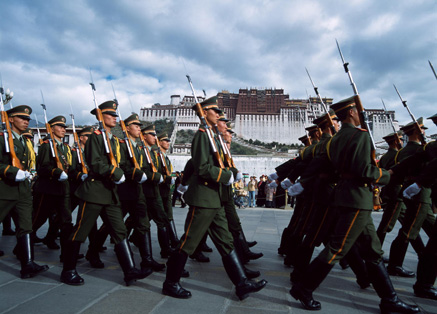
2. Tibetans: A Nation not a Minority
China Says: "As a member of the big family of the Chinese nation, the Tibetan people have created and developed their brilliant and distinctive culture during a long history of continuous exchanges and contacts with other ethnic groups" Liu Yandong, United Front (2a).
Reality: The PRC claims Tibetans are among 55 ethnic nationalities bound together by a common destiny (2b). This fabrication, rooted in China's deep historical ethnocentrism, became the foundation for China's colonization of Tibet and other neighboring territories (2c). Tibet is not only a clearly defined nation, but the government of Tibet fulfilled the criteria of a sovereign state three decades before the founding of the PRC. Prior to the invasion, Tibetans and Chinese had little to no contact and China did not formally exercise control over Tibet (2d). China's leaders however classified Tibetans as 'barbaric uncivilized' peoples that should be 'assimilated or eliminated' (2e). Tibetans, fiercely proud and independent, showed no signs of assimilating and thus the CCP pursued policies to eliminate the Tibetan nation.
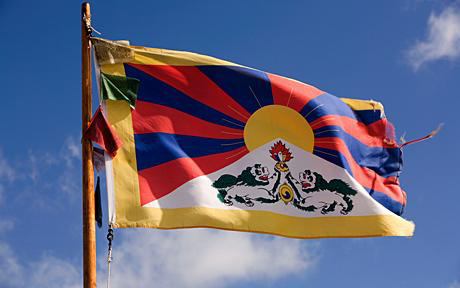
3. Rule by Force not Consent
China Says: "We must build up a Great Wall in our fight against separatism and safeguard the unity of the motherland, and push Tibet's basic stability towards long-term stability" Hu Jintao (3a).
Reality: After 60 years China still relies on military and paramilitary control of Tibet, control which is stepped up around sensitive anniversaries. Mass protests have continued across Tibetan areas since 2008, for example in eastern Tibet during 2014 in protest at the detention of abbot Khenpo Kartse. There are currently at least 824 political prisoners in Tibet (3b). Between 2008 and 2013, China’s national spending on public security almost doubled and for the last four years has exceeded the national defence budget (3c). China has never accounted for the thousands it detained in 2008, or the numerous deaths resulting from its security measures (3d), for example in August 2014 at least 10 Tibetans were injured when Chinese security forces opened fire on an unarmed gathering. Three of those were confirmed to have died of their wounds after being denied medical treatment (3e).
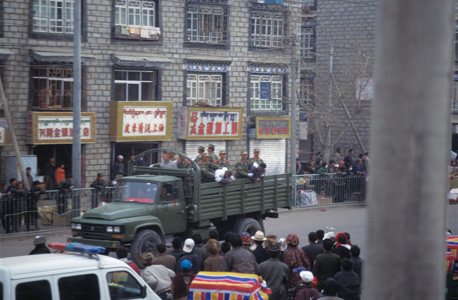
4. Poverty not Prosperity
China Says: "Tibet's gross domestic product (GDP) is expected to hit 92.5 billion yuan (15 billion U.S. dollars) in 2014,While several Chinese provinces have lowered their growth targets amid an economic downturn, the plateau region of Tibet has maintained a 12-percent growth target for 2015 with strong investment from the central government." (4a).
Reality: Despite vast investment in the TAR - with fixed-asset investment in the region expected to surpass 130 billion yuan in 2015 (4b) - these funds mainly benefit Chinese migrants and have actually contributed to the economic marginalisation of Tibetans. Andrew Fischer, an economist specialising in development who analysed Chinese government statistics calls Tibet's growth 'ethnically exclusionary' (4c). The speed and scale of Han Chinese migration onto the Tibetan plateau, and the unequal business and employment opportunities this migration creates, were some of the driving forces behind protests in Lhasa in 2008.
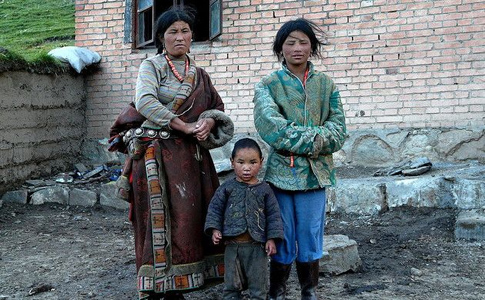
5. Dalai Lama: Peace Icon not Wolf
China Says: "We are in the midst of a fierce struggle involving blood and fire, a life and death struggle with the Dalai clique," TAR Party Secretary, Zhang Qingli. TAR Chairman Jampa Phuntsog was quoted by China Daily as saying the majority of Tibetan people do not want the Dalai Lama to return (5a).
Reality: The Dalai Lama is the pre-eminent representative of the Tibetan people and a globally respected icon of peace. He is viewed by Beijing as enemy number one, described as a "wolf in monk's robes" and "a monster with human face" (5b). His image is banned in Tibet (5c). Tibetan monks, nuns and laypeople who have self-immolated in Tibet have consistently called for the return of the Dalai Lama as well as freedom for Tibet. China called the Dalai Lama's prayers for those who died through self-immolation "terrorism in disguise" (5d). In January 2015, 15 officials were punished for supporting the Dalai Lama; China’s Global Times said they “participated in the illegal underground ‘Tibetan Independence’ organization, provided intelligence to the Dalai Lama clique and assisted activities that would harm national security” (5e). The Dalai Lama's decision in 2011 to devolve political power to an elected leadership has only strengthened his position; he remains the free spokesperson of the Tibetan nation.
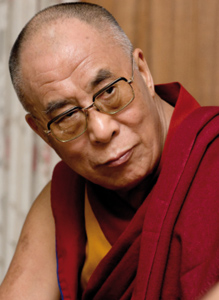
6. Language: Assimilation not Protection
China Says: "All nationalities have the freedom to use and develop their own spoken and written languages," Article 4, Constitution of the PRC (6a).
Reality: "..there are few lucrative job prospects for Tibetans who have not been educated in Chinese. Nor [can] a student educated in Tibetan acquire professional qualifications at college or university. There are no relevant courses taught in Tibetan" Tsering Dorje, teacher (6b). Since 2008 China has intensified efforts to marginalize the Tibetan language in favour of Chinese (6c). In October 2010 over 10,000 Tibetan students and teachers protested against proposed education reforms by Qinghai Province, which aimed to change the primary language of instruction from Tibetan to Chinese (6d). Street signs are in Chinese, official documents generally only available in Chinese and letters addressed in Tibetan are not delivered. In spite of China's efforts, a resurgence of the Tibetan language as an expression of identity is underway in Tibet (6e).

7. Occupation is No Holiday
China Says: In 2014, Tibet received 15.53 million tourists and its annual tourism revenue hit 20 billion yuan RMB, increasing 20% and 23% respectively (7a).
Reality: With millions of domestic and overseas visitors each year Beijing expects tourism, a designated 'pillar industry', to accelerate economic development in Tibet. Whilst attempting to maximize tourism's profitability, the authorities control what tourists see and understand. Tour guides and hoteliers are under pressure to provide an officially sanctioned version of Tibetan history. Guides risk suspension and imprisonment for perceived indiscretions including befriending tourists or disregarding the party line. The Tibet Autonomous Region is regularly closed to tourists during sensitive anniversaries or visits by Chinese leaders, officials occasionally citing 'limited accommodation capacity' (7b), despite several international hotels, including the St Regis (7c) and now InterContinental’s Resort Lhasa Paradise having recently opened in Lhasa.
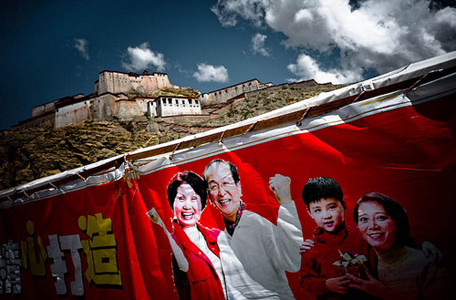
8. Oppression not Emancipation
China Says: "without the peaceful liberation of Tibet, the entry of the Chinese Communist Party and the PLA, those oppressed and enslaved Tibetan people would not have deeply understood the policy of the CPC", Zhu Weiqun, United Front (8a).
Reality: The Chinese Communist Party claims it liberated Tibet from the "oppressive, feudal rule of the Dalai Lama" (8b), a medieval, oppressive society consisting of 'landowners, serfs and slaves'. In March 2009 the Dalai Lama said that Beijing's policies "thrust Tibetans into such depths of suffering and hardship that they literally experienced hell on Earth" (8c). Ultimately, Beijing's condemnation of Tibet's 'feudal' past is a classic colonialist argument - 'backwardness' serving as a justification for invasion (8d). Pre-invasion, many Tibetans recognized inequalities in their system and the Dalai Lama had begun to promote improvements. The founding of 'serf-emancipation day' in 2009 is symbolic of China's continued colonial vision of Tibet, while the exiled Tibetan government is now a democracy (8e).
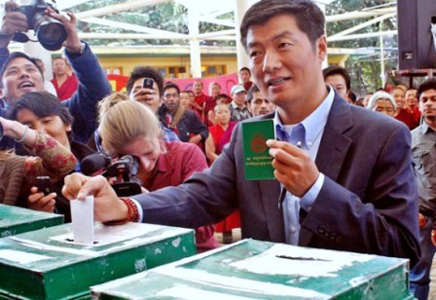
9. Religious Repression Not Freedom
China Says: "The region has perfectly implemented a policy granting freedom in religious belief and ensuring all Tibetan people enjoy such a right." Qin Yizhi, Lhasa Party Secretary (9a).
Reality: Since China's occupation, Tibetan Buddhism has been under attack to undermine the core belief system at its heart and sever loyalty to the Dalai Lama. An estimated 6,000 monasteries were destroyed and today the number of monks and nuns are vastly reduced, religious institutions tightly controlled and 'patriotic re-education' campaigns regularly carried out (9b). In April 2011 over 300 monks were removed from Kirti Monastery in eastern Tibet following protests (9c). In 1995 six-year old Gedhun Choekyi Nyima, the Dalai Lama's choice of 11th Panchen Lama, disappeared and remains missing, and in 1999 the 17th Karmapa felt compelled to flee Tibet. China now insists that permission to reincarnate must be given by the government (9d). The United States Commission on International Religious Freedom’s 2014 Annual Report states that “For Tibetan Buddhists and Uighur Muslims, conditions are worse now than at any time in the past decade”. (9e)
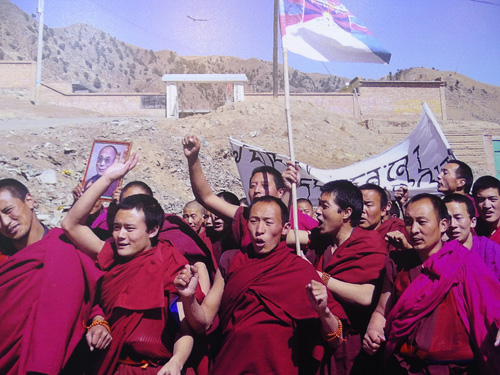
Photograph: Adam Jones
10. Crisis at the Third Pole
China Says: Strengthening environmental protection on the Tibetan plateau is important for "maintaining border stability, ethnic unity and the building of a well-off society," State Council statement (10a).
Reality: Tibet, known as the Third Pole because it holds the third largest store of glacial freshwater, is warming twice as fast as the rest of the world. Glacial melt from the plateau is disrupting water supplies, threatening sustainable livelihoods and putting more than one billion downstream peoples at risk (10b). Since occupying Tibet, China's policies have brought region-wide famine, desertification on the grasslands, acute flooding from clear-cutting Tibet's forests, and environmental destruction through unregulated mining (10c). China's solution is to build more dams, which will deny downstream users a stable supply of water. In turn, China blames Tibet's nomads, not its own policies, for threatening China's precious water resources.
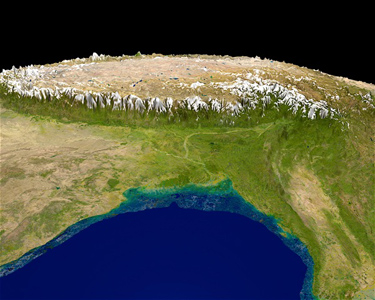
11. Colonization with Chinese Characteristics
China Says: "In carrying out the strategy of large-scale western development, development will be greatly accelerated and human talent will flow westward." Li Dezhu, State Ethnic Affairs Commission (11a).
Reality: A 1980s 'open door' policy encouraged Chinese workers into the TAR. The 2000 census gives the population of the entire Tibetan Plateau - including 150 Tibetan autonomous counties - as at least 10 million, excluding military and migrant workers. 5.4 million are listed as Tibetan; the remainder Han or other Chinese people (11b). In 2002 officials admitted encouraging Chinese migration, telling journalists Tibetans would soon be in a minority in Lhasa and that the influx of Chinese migrants was part of a drive to develop the economy, bring prosperity and stability (11c). The reality of colonial life for many Tibetans consists of discrimination and exclusion.
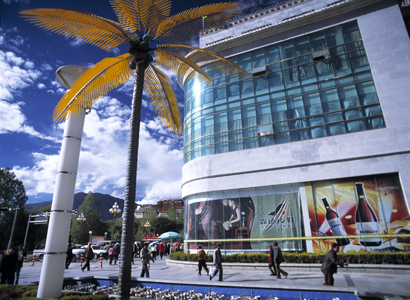
12. Forcing Nomads off Land
China Says: 'All herdsmen are expected to end the nomadic life by the end of the century'; report quoting Qi Jingfa, Agriculture vice-minister 1998 (12a).
Reality: At least 2.25 million Tibetans live nomadic or semi-nomadic lives, a way of life that is an intrinsic part of Tibetan society (12b). Following the occupation, nomads were classified as 'uncivilized' and their lifestyle threatened by China's agricultural and collectivisation policies (12c). Although China missed its 2000 deadline to end nomadic life, efforts to force Tibetans into ghetto-style housing blocks have intensified since the launch of China's 'Western Development Plan'. In January 2011, officials said 1.43 million farmers and herders had new homes (12d) and in 2012, China’s State Council approved a plan to start settlement projects for 1.16 million rural herdsmen by 2015 (12e). Land, seized under false claims of 'environmental protection' in the age of climate change, is cleared largely to make way for dams and mining operations. For thousands of years, Tibetan nomads lived sustainably on the grasslands; now China's policy of 'converting rangelands to pastures' is leading to overgrazing in fenced-in areas and exacerbating desertification (12f). Coercive settlement is causing economic and social problems (12g), likely to fuel greater unrest.
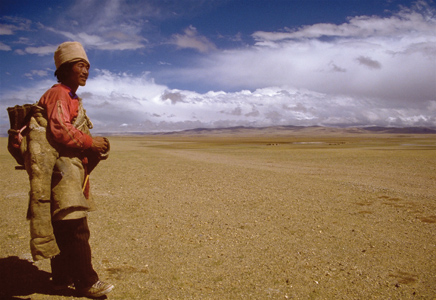
13. Railroading Tibet
China Says: "In 2014, investment from the central government, state-owned enterprises and the private sector reached 35.3 billion yuan, 10 billion yuan and 30 billion yuan, respectively. The combination of the three accounted for 81 percent of Tibet's 2014 GDP. Operation of the 251-km Lhasa-Xigaze railway and the Zangmu Hydropower Station in 2014, at a cost of 13.28 billion yuan and 9.6 billion yuan respectively, greatly boosted economic growth in Tibet." (13a). "Although our top priority is to realize a leapfrog development, maintaining social stability is of great importance," Zhang Qingli (13b).
Reality: China's financial investment in Tibet is substantial, but the emphasis on large infrastructure rather than community-led projects has delivered patchy development that seldom benefits the poorest Tibetans. The most significant project is the Gormo-Lhasa Railway, completed July 2006, which has accelerated the influx of Chinese into Tibet, further excluding Tibetans from the local economy, exacerbating resentment and thereby making China's aimed-for 'stability' more unlikely. The Railway also facilitates the swift deployment of military, the exploitation of Tibet's natural resources and threatens both Tibetans' nomadic lifestyles and the Tibetan environment itself (13c).
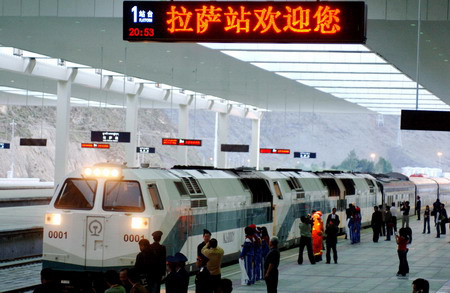
14. Control of the Water Tower
China says: '"Although Tibet is rich with water and hydropower resources, water resources are still one of the key factors in restricting Tibet's development" Zhang [Qingli] stressed it is of great urgency to develop water infrastructure projects in Tibet' (14a).
Reality: As in other development projects, Tibetan voices have been absent from decision-making about dam construction. Until recently Tibet hosted the largest undammed river in the world, the Yarlung Tsangpo, but in 2014, the first of a series of dams on the river, proposed to be the world's biggest hydro-power scheme (called the ‘Zangmu Project’) started generating power (14b). Concerns about the possible impacts of these dams include downstream nations' access to a safe, stable water supply (14c), the risk of damming rivers in seismic activity areas, as evidenced by the devastating earthquakes in Nepal of 2015 (14d) and threats to the most bio-diverse region in the world (14e).
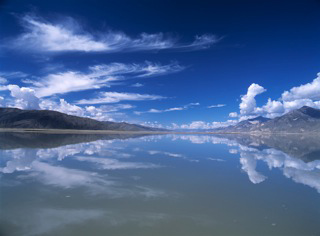
15. Long life: Not for Dissidents
China Says: 'Life expectancy of Tibetans is 67 years, almost double the 35.5 years prior to the liberation of Tibet. Between 2006 and 2010 1.7 billion yuan was spent to finance free medical services for Tibetan farmers and herders' (15a).
Reality: Infant and child mortality rates remain among the highest in the world. Coercively settled nomads report that promised healthcare provision is seldom available, whilst Tibetans generally find healthcare unaffordable (15b). The rise in prostitution in Lhasa raises concerns about AIDs. Dissent significantly affects life expectancy; those injured in demonstrations are too afraid to seek medical treatment and deaths linked to detention are common. In 2014, Goshul Lobsang and Tenzin Choedak both died days after release from prison as a result of torture endured during their detention (15c), and in July 2015, Tibet's most prominent political prisoner, buddhist leader Tenzin Delek Rinpoche died in prison, 13 years into a life sentence (15d).
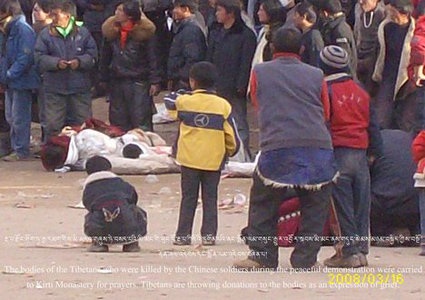
16. A Second Cultural Revolution
China Says: "The government has dedicated a large amount of manpower, materials and funds to the protection and promotion of fine traditional Tibetan culture... bringing about unprecedented protection and development of Tibetan culture." White Paper 2008. "Anyone possessing illegal music or videos will be severely dealt with." Shigatse School website (16a).
Reality: Beijing has always relied on music and song to deliver propaganda, but the authorities maintain a roster of 'acceptable' Tibetan singers; dozens of Tibetan language songs are banned and security checkpoints regularly check Tibetans' phones for illegal songs and ringtones (16b). Some 30 Tibetan writers and performers have been detained and served sentences, including singer Tashi Dhondup (16c) but despite this, increasing numbers of artists are reasserting their cultural identity, calling for unity among Tibetans, and celebrating the enduring spirit of the Tibetan people.
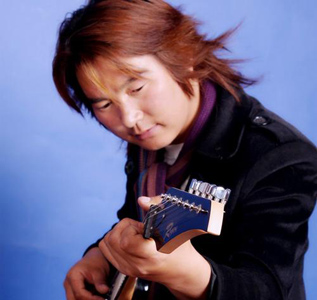
17. Happiness at Gunpoint
China Says: CCTV announced that Lhasa was awarded the '2010 City With the Happiest People' (17a).
Reality: Tibetan writer and intellectual Woeser responded "living under gunpoint day and night, being followed by snipers even when going to the temple to pray, how can there be any sense of happiness? Is it possible that after such a short time, Lhasa people left behind the gory terror of 2008 and their faces were wreathed in smiles again? Since they are happier than so many other people from many other Chinese cities, why do they still take to the streets?" (17b).
To read Woeser's blogpost "Happiness under Gunpoint" in full, click/go here
